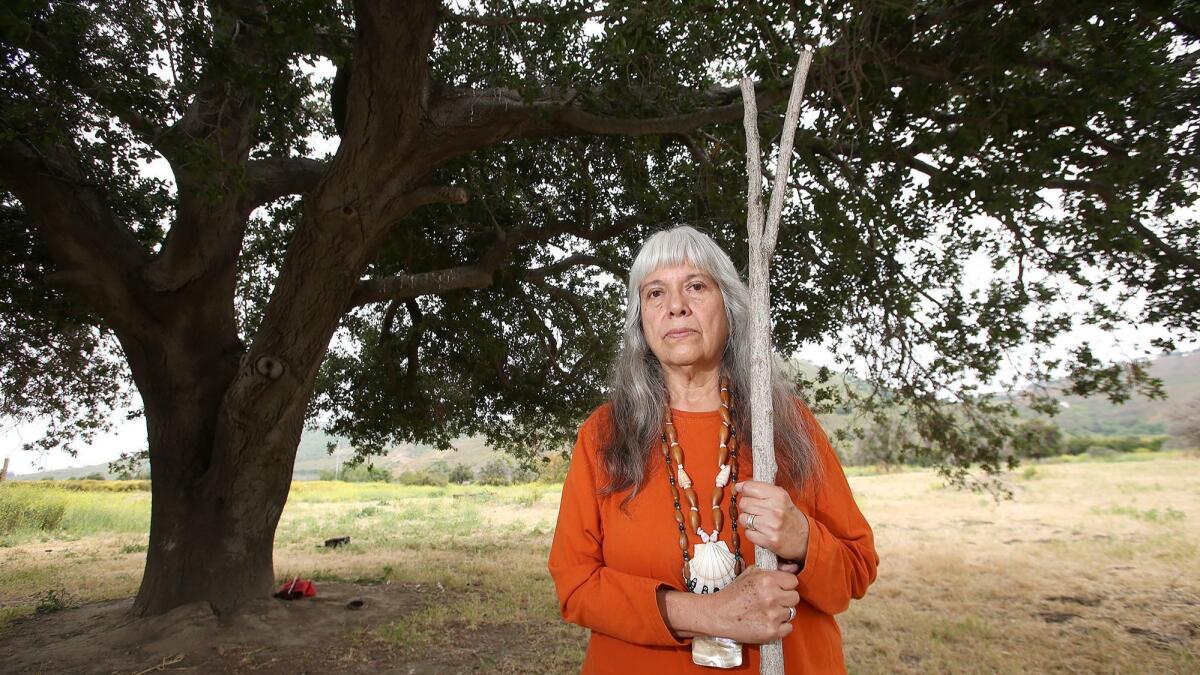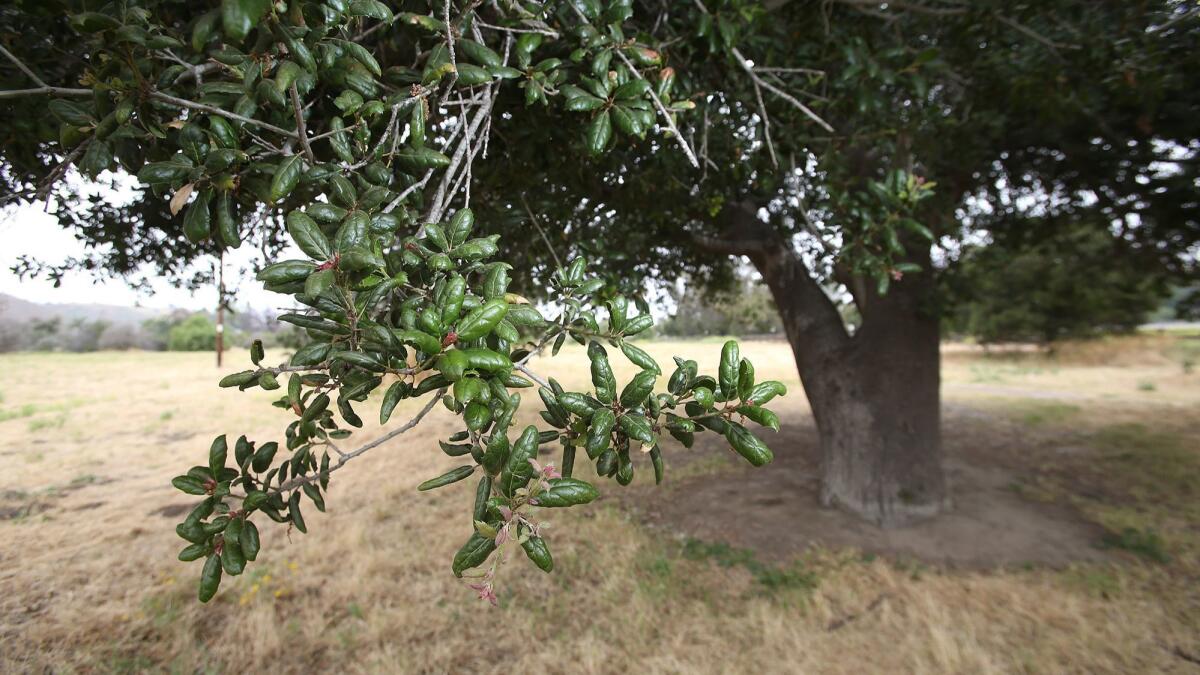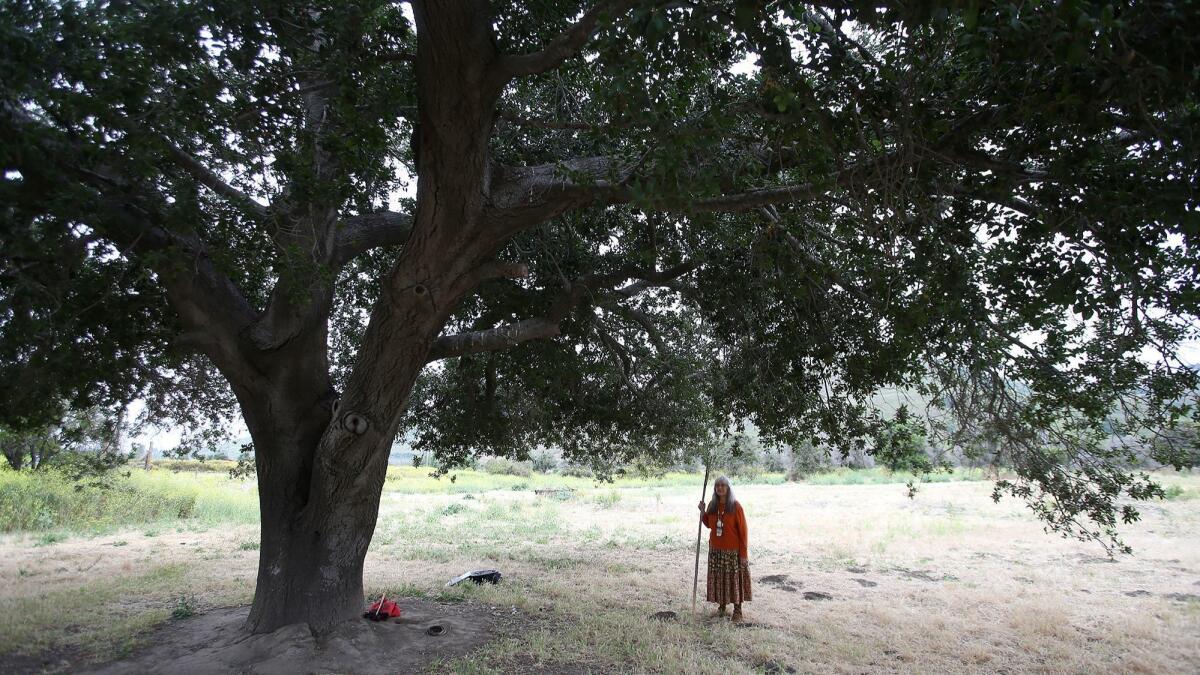Juaneño spiritual leader seeks to preserve the old ways

- Share via
Adelia Sandoval sat at the foot of an old oak tree.
A gentle breeze shifted the leaves.
Sunlight shone through the interstices, casting moving shadows on the ground.
“The older trees are witnesses to what we do,” she said, hands folded in her lap as she looked up. “This one I call Mother Tree.”
Sandoval, spiritual leader of the Juaneño Band of Mission Indians, has been visiting the tree for the last few years, honoring it by sprinkling sage and saying a prayer. She pays reverence to the oak because it stands on the grounds of one of the first Native American settlements in what became Orange County — the 65-acre Northwest Open Space in San Juan Capistrano.
But the land of the old village is different now.
Whatever natural silence still lingering from the past is accompanied by the hum of the nearby 5 Freeway and an occasional passing train. Cars kick up dust as they head to the neighboring dog park or winery. Large houses straddle the mountains to the west.
Sandoval and her tribe have been fighting for the last few years to create a humble 1-acre educational park and cultural center at the site called Putuidem Village. It would serve as a monument to the first people of Orange County and provide a venue for the tribe to teach its members and the public about its history and traditions. Sandoval would also lead important ceremonies on the site, including mourning the dead.
But tribal members have been worried that the project won’t ever be completed due to continual delays from the City Council. Members once again voted in April to delay construction in lieu of two workshops being held on June 5 and June 24, when the public can provide input on the proposed park and cultural center.
“Let’s pump the breaks on this,” Mayor Pro Tem Troy Bourne said at the meeting, urging the council to wait until after the community forums to gauge public opinion.
Mayor Brian Maryott said he was tired of the delays.
“This has been going on for so long, and tonight we are splitting hairs about words in our zoning regulations,” Maryott said.
For Sandoval, the land is imbued with meaning, serving as a link to the past and guide to the future.

Sandoval, 66, of Tustin has always had a familiarity with her ancestral roots. While growing up in Santa Ana, her mother and father maintained close ties to the tribe.
“We were very aware of the tribe growing up,” Sandoval said. “They would bring us to barbecues and other gatherings when we were little. We always knew we were Juaneño.”
She wanted a connection to her roots
As Sandoval aged, she craved a closer connection to the old ways.
After the bodies of several tribal ancestors were unearthed in Rancho Mission Viejo in the early 1990s, a ceremony to honor the deceased was held near the San Mateo campgrounds in San Clemente. Cathy Lobo, who went by Ka’chi, led the ceremony, teaching those in attendance the four main dances of each clan — deer, eagle, wolf and bear.
Sandoval learned that her family was in the bear clan. Learning the traditional dance left a lasting impression.
“The ceremony was one of the most powerful experiences of my life, and I will never forget it as long as I live,” Sandoval said. “It was beautiful. We danced all night long. I remember the stars sparkling in the sky and the sun slowly coming up. I never felt so good in my life. It was like I found my home … my place to be.”
Ka’chi became Sandoval’s teacher.
Sandoval balanced her lessons while managing care and halfway homes with her sister for people with mental illness. Much of what Sandoval knows today was gleaned from meetings with Ka’chi.
“She taught me about the stars and their significance,” Sandoval said. “She taught me about ceremony. She taught me how to impart wisdom to those in trouble.”
Sandoval learned that there are hidden messages in all things if one remains open. The flight path of the hawk, the ripple of the creek — there is an intelligence that runs through all things.
Ka’chi taught Sandoval how to ponder the important questions.
One ritual involved Sandoval sitting in a chair next to a creek with a “dream blanket” wrapped around her head. Ka’chi would give her a question to contemplate.
The dark and enveloping nature of the blanket would help Sandoval close herself off from the outside world, concentrating on the question her teacher had posed. Afterward they’d discuss what she’d learned.
Ka’chi’s body began to decline due to complications of diabetes; she died about four years ago.
“She was very sick,” Sandoval recalled. “She had a body that didn’t support her spiritual power. She was an amazing woman. I miss her.”
Torch passes from teacher to student
Before she died, Ka’chi asked Sandoval to take her place as a spiritual leader of the tribe.
“To be honest I tried to get out of it,” Sandoval said. “I said, ‘I don’t know if I can do this.’ She told me, ‘there is nobody else.’ ”
After Ka’chi died, Sandoval began referring to her as “Starmother.”

Sandoval is tasked within the tribe with leading ceremonies, visiting the sick and elderly and preserving the rituals of their ancestors.
“My role is to keep things alive as I can,” Sandoval said.
Sandoval tries to keep the youth involved. Relying on oral tradition, she uses storytelling, ceremony and repetition to pass along customs.
“Sometimes people want to write it down. I say, ‘just listen,’ ” Sandoval said.
She holds monthly meetings, including regular gatherings at the oak tree. In April, she held a planting stick ceremony, which celebrates the fertilization of plants in spring.
But with all the gadgets of modernity competing for the attention of young minds, it isn’t easy to get children interested in the old ways.
“If I can just get a handful of them to be interested, then they can keep it going,” Sandoval said.
Keeping these customs alive is vitally important to Sandoval because much has already been lost.
The sacred sites and lands of the Acjachemen descendants, whose history traces thousands of years, have been plundered, desecrated and devoured by development. They became known as the Juaneños after Spanish colonialists built Mission San Juan Capistrano in 1776. Today there are about 1,900 members in the tribe.
Sandoval said the Juaneño people lost many of their traditional ways during the missionary era. The old stone church at the mission, now a tourist destination, was built by the Juaneño in the early 1800s.
“The Spaniards considered them people of no reason,” Sandoval said. “Much was lost. But we do have some things, and those are very precious to us.
“People have accused me of being too romantic about our ancestors, but I have learned a lot about them to think, ‘Why shouldn’t I be?’ They were magical people. They were extremely brilliant especially those studying cosmology and the stars. They had knowledge and wisdom.”
Sandoval returns to the old oak regularly to feel like a part of the land. She sits and ponders the past and future of the tribe, one which may be presaged in the land itself.
“You see that yellow,” Sandoval said. “That’s wild mustard. There was no mustard before the Spanish came here.”
The invasive mustard plant dapples the site of the old village and nearby mountains. The invader chokes the native plants.
But the yellow is diminishing, relenting space to the wild sweet pea — the definition of Acjachemen.
“The mustard is dying now,” Sandoval said. “The wild sweet peas are blooming. When you get out of your car and breathe in, it is so fragrant. The red and purple and pink and white. They are growing everywhere.”
She paused.
“Resilience is in our nature.”
All the latest on Orange County from Orange County.
Get our free TimesOC newsletter.
You may occasionally receive promotional content from the Daily Pilot.




